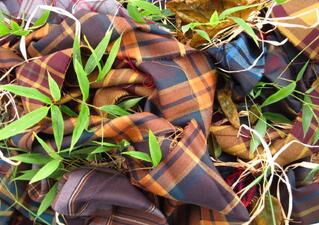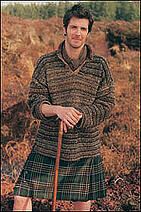

It is believed the kilt first appeared as the great kilt during the 16th century and is Gaelic in origin. The Kilt at that time was a full-length garment whose upper half could be worn as a cloak draped over the shoulder, or brought up over the head. One typically wore many type of kilts depending on their family heritage.
The fabric was at first pleated, ten wrapped around the body and belted, with a skirt like lower half, and an upper portion that wrapped over the shoulder. Indeed, dressed in such a way, the men were often referred to as ‘red shanks’ (or bare-legged) and prided themselves on their ability to withstand the rigors of the wet and harsh climate.
There also was a smaller kilt, or walking kilt as it was known (similar to the modern kilt) introduced sometime in the 1720s for the use of the Highlanders when working in logging or iron works during that era.
However, most historians do seem to agree that the kilt was adopted by Irish Nationalists around the turn of the twentieth century although many historians claim that the kilt has been worn in Ireland as far back as the sixteenth century.
Irish kilts are made from high quality garments and as you'd have seen over the years, can be used at a variety of occasions.
You can check out our latest fabrics here; Special Offers- O'Neil of Dublin.
Pleating, the art of...
The art of pleating is an integral piece withing the clothing business and there are three basic ways in which to pleat fabric: by hand, patterns or machine. These three separate forms of pleating can be combined to create different results and looks.
1. Hand Pleating. The art of hand pleating is whereby a piece of fabric is folded by hand, to create a pleat and then to repeat this method so as to create pleat by pleat, fold by fold. This is a very time consuming method of pleating although it is much easier with tartans and checks since the repeat of the design can be used as a guide when arranging the folds. This method of pleating is not very practical and we use it only used in particularly situations only, mainly at design concept stage when contemplating new folds and structures. Of course for production, the process is made easier with pattern and particularly machine pleating.
2. Pattern Pleating. This form of pattern is used for particular pleat form, especially where in a pleating design that cannot be produced by a pleating machine. It is particularly suited to the sunray pleat design which is a where a skirt is cut on the bias so as to create pleats that are narrower at the top than at the bottom, producing a flared effect and which is used mainly for skirt styles. For this form of pleating, a card pattern is produced first and then the fabric is inserted within the pattern, folded together so that the fabric inside is folded tight and after a heat steaming process, enables the pleats to remain in place as the new structure and design. While today, most of our pleating is created by larger pleating machines, the art of pattern pleating is still used in certain situations and particularly where style require irregular pleating styles that would not be suitable for machine pleating.
3) Machine Pleating. In today’s manufacturing situations, the art of machine pleating comes into it’s own as it is a much more efficient and economical way to pleat fabric, as well as offering an enormous variation of pleating styles possible. Long lengths of fabric can be pleated at the same time and the obvious labour costs in this are greatly reduced. The pleating machine has long blades which grab the fabric as it is fed into the machine and then with the aid of the pleating computer programme, the number of pleats required and pleat design is created to whatever design we require. The opportunities that the pleating machine offers are endless and gives us the versatility to adapt pleats to whatever design we require.
Feel free to check out our latest latest article, on the History of the kilt.
Topics: Hand pleating, machine pleating, pattern pleating, the art of pleating